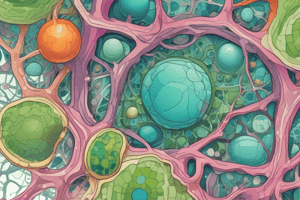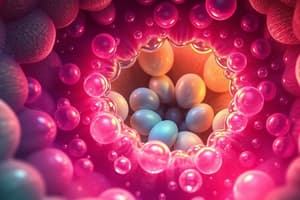Podcast
Questions and Answers
What is the main component of a plant cell wall?
What is the main component of a plant cell wall?
- Pectin
- Cellulose (correct)
- Lignin
- Hemicellulose
Which organelle is responsible for generating energy for the cell through cellular respiration?
Which organelle is responsible for generating energy for the cell through cellular respiration?
- Chloroplast
- Golgi Apparatus
- Mitochondria (correct)
- Endoplasmic Reticulum
What is the function of chromoplasts in plant cells?
What is the function of chromoplasts in plant cells?
- Responsible for photosynthesis
- Responsible for pigment synthesis (correct)
- Responsible for protein synthesis
- Responsible for storage and waste removal
What is the function of vacuoles in plant cells?
What is the function of vacuoles in plant cells?
What is unique to plant cells?
What is unique to plant cells?
What is the function of the Golgi apparatus in plant cells?
What is the function of the Golgi apparatus in plant cells?
What is the function of plasmodesmata in plant cells?
What is the function of plasmodesmata in plant cells?
What is the main function of plant cells?
What is the main function of plant cells?
Flashcards are hidden until you start studying
Study Notes
Structure of Plant Cells
- Plant cells are eukaryotic cells, meaning they have a true nucleus and membrane-bound organelles.
- They have a cell wall, which provides support, protection, and shape to the cell.
- The cell wall is made up of:
- Cellulose (main component)
- Hemicellulose
- Pectin
- Lignin (in some plants)
Organelles in Plant Cells
- Plastids: responsible for photosynthesis and pigment synthesis
- Chloroplasts: contain the pigment chlorophyll and are responsible for photosynthesis
- Chromoplasts: contain pigments other than chlorophyll and are responsible for coloration
- Vacuoles: responsible for storage, waste removal, and maintenance of cell turgor pressure
- Mitochondria: responsible for generating energy for the cell through cellular respiration
- Endoplasmic Reticulum (ER): responsible for protein synthesis, transport, and storage
- Golgi Apparatus: responsible for protein modification, sorting, and secretion
- Lysosomes: responsible for cellular digestion and recycling
Unique Features of Plant Cells
- Plastids: plant cells have the ability to undergo photosynthesis due to the presence of chloroplasts
- Cell Wall: plant cells have a rigid cell wall that provides support and structure
- Vacuoles: plant cells have large vacuoles that help maintain cell turgor pressure and store nutrients and waste
- Plasmodesmata: plant cells have plasmodesmata, which are narrow channels that connect adjacent cells and allow for direct communication and transport of molecules
Functions of Plant Cells
- Photosynthesis: plant cells undergo photosynthesis to produce energy and organic compounds
- Support and Structure: plant cells provide support and structure to the plant through their cell walls
- Storage: plant cells store nutrients, water, and waste products in their vacuoles
- Growth and Development: plant cells are involved in growth and development of the plant through cell division and differentiation
Characteristics of Plant Cells
- Plant cells are eukaryotic, with a true nucleus and membrane-bound organelles.
- They have a cell wall, which provides support, protection, and shape to the cell.
Composition of Cell Wall
- Cellulose is the main component of the cell wall.
- Other components include hemicellulose, pectin, and lignin (in some plants).
Plastids
- Plastids are responsible for photosynthesis and pigment synthesis.
- Chloroplasts contain chlorophyll and are responsible for photosynthesis.
- Chromoplasts contain pigments other than chlorophyll and are responsible for coloration.
Functions of Other Organelles
- Vacuoles are responsible for storage, waste removal, and maintenance of cell turgor pressure.
- Mitochondria generate energy for the cell through cellular respiration.
- Endoplasmic Reticulum (ER) is responsible for protein synthesis, transport, and storage.
- Golgi Apparatus is responsible for protein modification, sorting, and secretion.
- Lysosomes are responsible for cellular digestion and recycling.
Unique Features of Plant Cells
- Plastids enable plant cells to undergo photosynthesis.
- The rigid cell wall provides support and structure to the plant.
- Large vacuoles help maintain cell turgor pressure and store nutrients and waste.
- Plasmodesmata are narrow channels that connect adjacent cells, allowing for direct communication and transport of molecules.
Functions of Plant Cells
- Plant cells produce energy and organic compounds through photosynthesis.
- They provide support and structure to the plant through their cell walls.
- They store nutrients, water, and waste products in their vacuoles.
- They are involved in growth and development of the plant through cell division and differentiation.
Studying That Suits You
Use AI to generate personalized quizzes and flashcards to suit your learning preferences.




